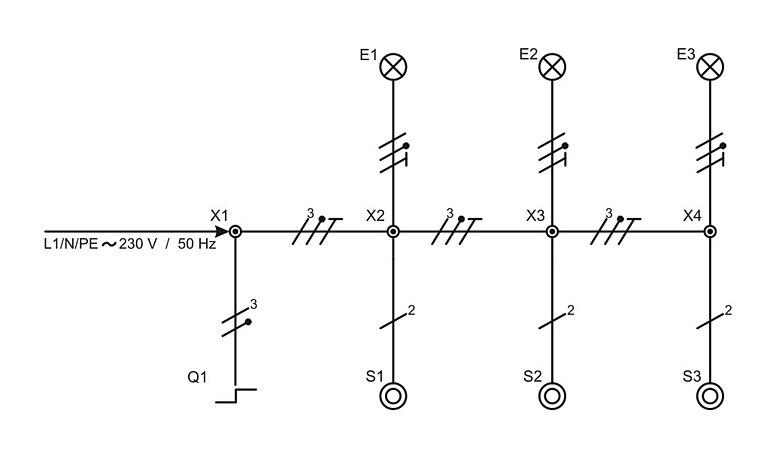Push button circuit


A button circuit is a circuit with buttons and relays or contactors , which usually works with a control circuit that is separate from the load circuit. Typical applications are switching the lighting on and off in stairwells and long corridors .
House installation
In house installations, a push button circuit is usually used when it is to be operated from more than 2 places. In contrast to the cross connection , it does require an impulse switch (relay), but it requires less cable and the circuit is less complex. In addition, a staircase time switch ( time relay ) can be used instead of a simple switching relay .
With push-button switching, the load current does not flow through the control points, but rather over a short route directly to the electrical consumer , for example to the light source . As a result, and due to the possible thinner cross-sections of the control lines, line losses and installation costs are reduced. The parallel connection of all buttons also reduces the installation effort. It can be operated from any number of buttons.
The relay is usually mounted in the distributor , less often in a junction box .
Impulse switching
The result of pressing a button, for example in the hallway, depends on the status of the connected impulse relay . If it was switched on before, it will be switched off and vice versa. This is often achieved by a mechanical lock, similar to that of a ballpoint pen, which engages once and is released again when you press it again. In the case of stairwell switching, the impulse relay is switched off by a time contact.
There is an advantage when using impulse switches with a low operating voltage ( protective extra- low voltage ): The button can then be installed with a bell cable. This variant can be found z. B. in most prefabricated houses type WBS70 in the area of the former GDR. Only one 12 V safety extra-low voltage source (transformer) is required per staircase, which supplies all apartments.
Electronic impulse switches
The control takes place in the same way as with the electromagnetic version, but the switching noise is greatly reduced and the control power requirement is lower. The permanent power supply, which was necessary for the first electronic impulse switches, can now be dispensed with. These switches work with bistable relays that are electronically controlled in the opposite direction with each switching pulse. In order to switch the relay to the required position, the electronics must either remember the previous switching status or read it out via an auxiliary contact before each switching command.
Staircase time switch
In the case of staircase lighting, all buttons can be switched on and after a time that can be set on the staircase lighting, it switches off again automatically.
example
The following illustrations show a surge circuit with 3 buttons (each located in a switch terminal box) and a surge relay that switches three lamps connected in parallel. The relay is usually located in the sub-distribution . The interconnection at points X2 to X4 could be made in distribution boxes . NYM-J cables are often used for installation . In this case 3 × 1.5 mm² would be used as leads to the lamps, a two-wire lead would be sufficient for the buttons instead and all other leads are 5 × 1.5 mm².
Similar circuits
In machines, the self-holding circuit is widespread, in which an NO and a separate NC button are connected in series to the actuating coil of a contactor . The normally open button is bridged with a normally open contact of the contactor. This circuit is usually not referred to as a push button circuit, but it is similar in terms of content and function.
A characteristic of many electronic devices is the complete lack of a power switch - switching on and off is effected by buttons on the low-voltage level, which inevitably requires the power supply to be in standby . Although this leads to greater ease of use, it also results in a not inconsiderable additional power consumption.
The buttons can be assigned different and changing functions using the software of the connected controller. Switching functions such as a self-holding circuit or an impulse switch can also be implemented.
literature
- Günter Springer: Expertise in electrical engineering. 18th edition, Verlag - Europa - Lehrmittel, Wuppertal, 1989, ISBN 3-8085-3018-9
- Alfred Hösl, Roland Ayx, Hans Werner Busch: The electrical installation in accordance with regulations, residential construction, commercial industry. 18th edition, Hüthig Verlag, Heidelberg, 2003, ISBN 3-7785-2909-9
- Hans-Günter Boy, Uwe Dunkhase: Electrical installation technology The master's examination . 12th edition, Vogel Buchverlag, Oldenburg and Würzburg, 2007, ISBN 978-3-8343-3079-6


